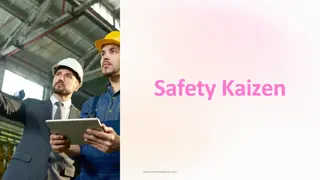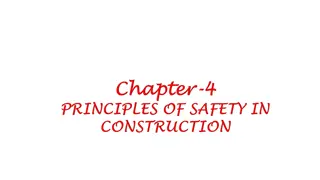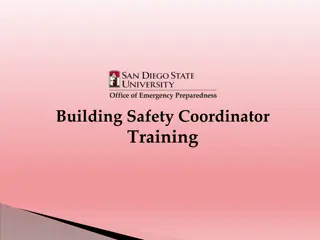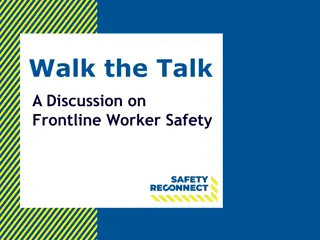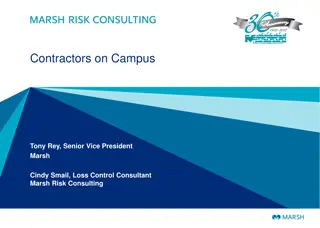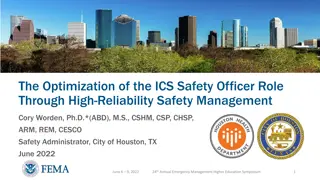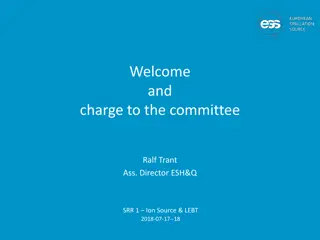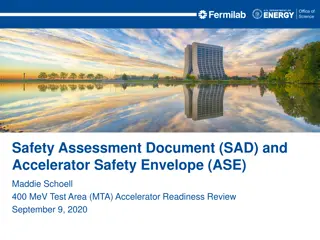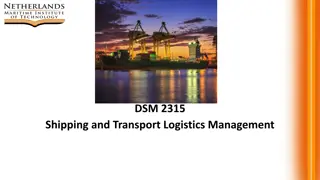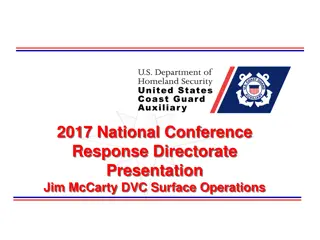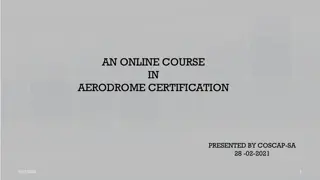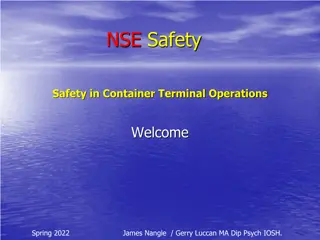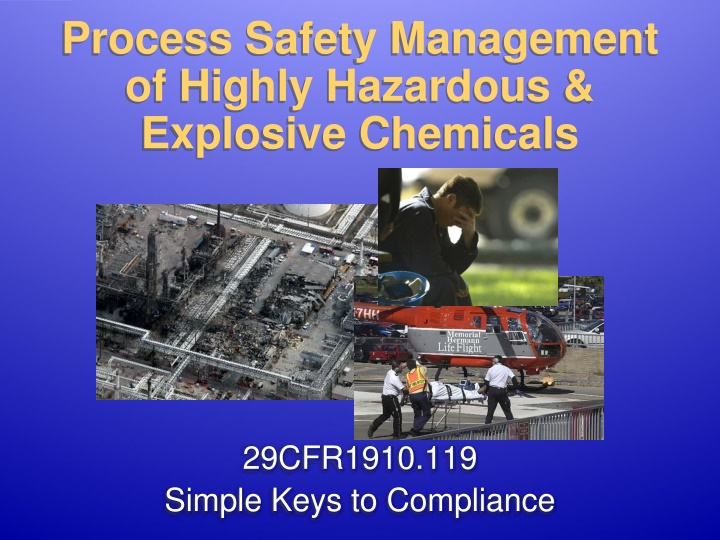
Key Aspects of Process Safety Management
This content delves into Process Safety Management (PSM) of Highly Hazardous & Explosive Chemicals under 29CFR1910.119. It covers the definition of PSM, who is governed by the standard, elements of the standard, why OSHA developed PSM, past disasters that led to its establishment, and the difference between PSM and the Risk Management Program (RMP).
Download Presentation

Please find below an Image/Link to download the presentation.
The content on the website is provided AS IS for your information and personal use only. It may not be sold, licensed, or shared on other websites without obtaining consent from the author. If you encounter any issues during the download, it is possible that the publisher has removed the file from their server.
You are allowed to download the files provided on this website for personal or commercial use, subject to the condition that they are used lawfully. All files are the property of their respective owners.
The content on the website is provided AS IS for your information and personal use only. It may not be sold, licensed, or shared on other websites without obtaining consent from the author.
E N D
Presentation Transcript
Process Safety Management of Highly Hazardous & Explosive Chemicals 29CFR1910.119 Simple Keys to Compliance
Objectives Define what is PSM and who is covered by the standard List the elements of the PSM standard 2
What Is Process Safety Management? PSM: Addresses the management of Highly Hazardous Chemicals (HHC) Integrates Technology Operating Procedures Standard management protocols 3
Why Did OSHA Develop PSM? Past Disasters Current Disasters Perceived Weakness in PSM Program 4
Why Did OSHA Develop PSM? Bhopal, India (1984) 2,000 deaths Isocyanate release Pasadena, TX (1989) 23 deaths, 132 injuries Petroleum explosion Cincinnati, OH (1990) 2 deaths Explosion Sterlington, LA (1991) 8 deaths, 128 injuries Chemical release 5
Why Did OSHA Develop PSM? In 1991, OSHA and EPA respectively, Released the Standards, PSM & RMP that Applies to Those Companies that are Affected by The Standards. 6
Why Did OSHA Develop PSM? Process Safety Management is a regulation, promulgated by OSHA, intended to prevent an incident like the 1984 Bhopal Disaster And to Prevent Release of: Toxic, Reactive, Flammable, or Explosive chemicals 7
Not Only PSM, But RMP A great many industrial facilities must comply with OSHA's Process Safety Management (PSM) regulations as well as the CAA 112(r) EPA Risk Management Program (RMP) regulations (Title 40 CFR Part 68). 8
PSM vs. RMP - Whats the Difference? RMP-Like Sara Title III Protects the Community Protects the General Public Around the Facility Protects Adjacent Facilities Such as Schools & Hospitals PSM - Like HAZCOM Protects the Workforce Protects Contractors Protects Visitors to the Facility Basically Protects the Workplace 9
The Standard Was Promulgated in 1991 - Is it Working? 10
The Standard Was Promulgated in 1991 - Is it Working? BP Products Texas City - March 2005 15 Workers Killed 170 Injured Major Property Damage $50.6 Million in Fines 11
The Elements of the PSM Standard Application Exclusions Definitions Employee Participation Hazards of the Process Toxicity Technology of the Process Equipment in the Process Mechanical Integrity Inspection & Testing Quality Assurance Process Hazard Analysis Management of Change Operating Procedures Safe Work Practices Training Contractor Management Emergency Planning & Response Incident Investigation Compliance Audits Trade Secrets 12
The Elements of the PSM Standard Application Exclusions Definitions Employee Participation Hazards of the Process Toxicity Technology of the Process Equipment in the Process Mechanical Integrity Inspection & Testing Process Hazard Analysis Management of Change Operating Procedures Safe Work Practices Training Contractor Management Emergency Planning & Response Incident Investigation Compliance Audits Trade Secrets 13
The Elements of the PSM Standard Application Exclusions Definitions Employee Participation Hazards of the Process Toxicity Technology of the Process Equipment in the Process Mechanical Integrity Inspection & Testing Quality Assurance Process Hazard Analysis Management of Change Operating Procedures Safe Work Practices Training Contractor Management Emergency Planning & Response Incident Investigation Compliance Audits Trade Secrets 14
The Elements of the PSM Standard Process Hazard Analysis Management of Change Operating Procedures Safe Work Practices Training Contractor Management Emergency Planning & Response Incident Investigation Compliance Audits Trade Secrets Application Exclusions Definitions Employee Participation Hazards of the Process Toxicity Technology of the Process Equipment in the Process Mechanical Integrity Inspection & Testing Quality Assurance 15
The Elements of the PSM Standard Application Exclusions Definitions Employee Participation Hazards of the Process Toxicity Technology of the Process Equipment in the Process Mechanical Integrity Inspection & Testing Quality Assurance Process Hazard Analysis Management of Change Operating Procedures Safe Work Practices Training Contractor Management Emergency Planning & Response Incident Investigation Compliance Audits Trade Secrets 16
The Elements of the PSM Standard Process Hazard Analysis Management of Change Operating Procedures Safe Work Practices Training Contractor Management Emergency Planning & Response Incident Investigation Compliance Audits Trade Secrets Application Exclusions Definitions Employee Participation Hazards of the Process Toxicity Technology of the Process Equipment in the Process Mechanical Integrity Inspection & Testing Quality Assurance 17
The Elements of the PSM Standard Process Hazard Analysis Management of Change Operating Procedures Safe Work Practices Training Contractor Management Emergency Planning & Response Incident Investigation Compliance Audits Trade Secrets Application Exclusions Definitions Employee Participation Hazards of the Process Toxicity Technology of the Process Equipment in the Process Mechanical Integrity Inspection & Testing Quality Assurance 18
The Elements of the PSM Standard Process Hazard Analysis Management of Change Operating Procedures Pre-Start up Safety Review Hot Work Permit Safe Work Practices Training Contractor Management Emergency Planning & Response Application Exclusions Definitions Employee Participation Hazards of the Process Toxicity Technology of the Process Equipment in the Process Mechanical Integrity Inspection & Testing Quality Assurance 19
The Elements of the PSM Standard Process Hazard Analysis Management of Change Operating Procedures Pre-Start up Safety Review Hot Work Permit Safe Work Practices Training Contractor Management Emergency Planning & Response Application Exclusions Definitions Employee Participation Hazards of the Process Toxicity Technology of the Process Equipment in the Process Mechanical Integrity Inspection & Testing Quality Assurance 20
The Elements of the PSM Standard Process Hazard Analysis Management of Change Operating Procedures Pre-Start up Safety Review Hot Work Permit Safe Work Practices Training Contractor Management Emergency Planning & Response Application Exclusions Definitions Employee Participation Hazards of the Process Toxicity Technology of the Process Equipment in the Process Mechanical Integrity Inspection & Testing Quality Assurance 21
The Elements of the PSM Standard Process Hazard Analysis Management of Change Operating Procedures Pre-Start up Safety Review Hot Work Permit Safe Work Practices Training Contractor Management Emergency Planning & Response Application Exclusions Definitions Employee Participation Hazards of the Process Toxicity Technology of the Process Equipment in the Process Mechanical Integrity Inspection & Testing Quality Assurance 22
The Elements of the PSM Standard Process Hazard Analysis Management of Change Operating Procedures Pre-Start up Safety Review Hot Work Permit Safe Work Practices Training Contractor Management Emergency Planning & Response Application Exclusions Definitions Employee Participation Hazards of the Process Toxicity Technology of the Process Equipment in the Process Mechanical Integrity Inspection & Testing Quality Assurance 23
The Elements of the PSM Standard Process Hazard Analysis Management of Change Operating Procedures Pre-Start up Safety Review Hot Work Permit Safe Work Practices Training Contractor Management Emergency Planning & Response Application Exclusions Definitions Employee Participation Hazards of the Process Toxicity Technology of the Process Equipment in the Process Mechanical Integrity Inspection & Testing Quality Assurance 24
The Elements of the PSM Standard Let s Explore Some of the Elements 25
Application 1910.119(a) 26
What Facilities are Covered Those Who Use Chemicals in Appendix A: A List of highly hazardous chemicals, toxics and reactive (Mandatory). Contains a listing of toxic and reactive highly hazardous chemicals which present a potential for a catastrophic event at or above the threshold quantity Examples Chemical Anhydrous Ammonia 10,000 lbs Chlorine 1,500 lbs Threshold Quantity (TQ) 27
What Facilities are Covered A process which involves a flammable liquid or gas (as defined in 1910.1200(c) of this part) on-site in one location, in a quantity of 10,000 pounds (4535.9 kg) or more 28
What Facilities are Covered Important Interpretation: 2007 - 06/11/2007 - OSHA defines "on-site in one location" for Process Safety Management of Highly Hazardous Chemicals standard OSHA interprets "on-site in one location" to mean that the standard applies when a threshold quantity of a highly hazardous chemical (HHC) exists within an area under the control of an employer or group of affiliated employers. It also applies to any group of vessels that are interconnected, or in separate vessels that are close enough in proximity that the HHC could be involved in a potential catastrophic release. 29
What Facilities are Covered Affect of the Meer Decision: MEER ruling and theMEER Memorandum addressed in the Secretary's letter, OSHA's enforcement policy that the Agency would not cite employers forviolations of 1910.119 where stored flammable liquids in atmospheric tanks were connected to a process, unless the process outside ofthe amount in storage contained more than 10,000 pounds of the substance 30
What Types of Industries? Industries that Process Chemicals Such As: Industrial Organics & Inorganics Paints Pharmaceuticals Adhesives Sealants and Fibers Petrochemical facilities Paper Mills Food Processing with Anhydrous Ammonia over the TQ 31
Exclusions 1910.119(a)(1)(ii)(A) 32
There are Exclusions An employer is exempt from the requirements of PSM when: A threshold quantity of flammable liquids is stored in atmospheric tanks or transferred without the benefit of chilling or refrigeration Hydrocarbon fuels used solely for workplace consumption as a fuel (e.g., propane used for comfort heating, gasoline for vehicle refueling), If such fuels are not a part of a process containing another highly hazardous chemical covered by this standard 33
There are Exclusions Retail facilities; Oil or gas well drilling or servicing operations; or, Normally unoccupied remote facilities 34
Employee Participation 1910.119(c) 35
Now that we are required to comply, then what? Form a Team in Your Company, i.e.. Process Engineers Operators Safety Maintenance Management Consultants Remember You Can t Do it Alone! 36
Now that we are required to comply, then what? Form a Plan, Determine: Responsibilities Duties Reporting Document Control Progress Reports Tracking Changes Then Begin the Process of Developing & Implementing the PSM Program 37
Hazards of the Process 1910.119(d)(1) 38
The Requirements of the Standard - Hazard Determination Determine: Chemicals in Your Process Process Chemistry Quantity of Chemicals in lbs Compare to Appendix A List with Threshold Quantities (TQ s) 39
Toxicity Information 1910.119(d)(1)(i) 40
The Requirements of the Standard - Develop Toxicity Information Obtain Toxicity Information on the Chemical(s) in the Process MSDS are Typical Resource You May Need Other References, NIOSH Pocket Guide, ACGIH TLV s 41
Technology of the Process 1910.119(d)(2) 42
The Requirements of the Standard - Process Technology Block flow diagram or process flow diagram Process chemistry Maximum intended inventory Upper and lower limits Consequences of deviations 43
The Requirements of the Standard - Process Equipment Materials of construction Process and instrument drawings (P&ID s) Electrical classification Relief system design Ventilation system design Design codes Material and energy balances Safety systems 44
Equipment in the Process 1910.119(d)(3) 45
The Requirements of the Standard - Process Equipment Now: Identify Each Piece of Equipment in the Covered Process by P&ID, Block Diagram and Number Them Remember - Must Follow Form Must be Able to Track Each Number Through the Entire Program 46
Mechanical Integrity 1910.119(j) 47
The Requirements of the Standard - Process Equipment Mechanical Integrity Certificates Must be Obtained for Each Element of the Process Must be Marked with Numbering System that Follows Form 48
Process Hazard Analysis (PHA) 1910.119(e) 49
Process Hazard Analysis (PHA s) Arguably the Most Difficult Part of Performing the Standard PHA process is dynamic and subject to revision whenever changes are made Performed by Your PSM Team Takes Significant Time & Effort PHA s are Never Ending 50




